Billy Gazonas helped put U.S. on soccer map and didn’t go by the book
- Share via
Chances are good you’ve never heard of Billy Gazonas. But chances are also good that, if not for Billy Gazonas, you might never had heard of Landon Donovan, Tim Howard or Megan Rapinoe either.
Gazonas was a soccer star in the United States at a time when the country barely acknowledged the sport. When he started college in 1973, it had been 23 years since the U.S. had played in a World Cup. It would be another 17 years before it would return.
Few noticed either way.
“It was a cult in the sense of there was nothing commercial attached to it,” said Paul Kennedy, who has written about the sport for nearly half a century. “It was so much different than it is today.”
Today, the U.S. women’s team, which didn’t exist when Gazonas played, is the two-time reigning World Cup champion. The men’s team ranks 22nd in the world, and MLS, the 25-year-old professional league, is seventh globally in average attendance. The country might not yet be a proper soccer nation, but it’s getting closer thanks to pioneers such as Gazonas, who kept soccer’s flame burning through a decades-long winter that threatened to extinguish it.
It’s a time Gazonas details in his autobiography “That Little Son of a B**tch!” — a provocative title the author doesn’t explain in print but revisited at the start of a recent phone interview.
In Apple’s “Ted Lasso,” Jason Sudeikis plays an American football coach turned English soccer manager. But the character’s origins date back almost 20 years.
“A lot of people felt I kind of played with a chip on my shoulder,” he said. “But when you’re a small player, you have to kind of establish yourself or people are going to be kicking you all over the field.”
Gazonas was 5 feet 3 and 132 pounds when he stepped off the playgrounds of Trenton, N.J., and onto the hallowed pitch at Hartwick College, a tiny private college in the foothills of New York’s Catskill Mountains that was then a college soccer power. Gazonas’ small body was about 95% heart, though, so when coach Timo Liekoski greeted the freshman by suggesting he enroll elsewhere if he wanted to play, Gazonas resolved to work tirelessly to make himself the best player he could be.
“I was obsessed,” said Gazonas, who secretly practiced alone for hours on a campus indoor racquetball court to improve his skills.
Four years later, he captained Hartwick to a national title and won the Hermann Trophy, college soccer’s equivalent of the Heisman.
Gazonas, a midfielder, never made the national team. It was a different era then, and the U.S. played just three exhibitions the year after he graduated, failing to score in all three. Then a knee injury limited him to four mostly frustrating seasons in the North American Soccer League, which largely had become a retirement league for aging European players before folding in 1985.
His real contribution was helping keep the sport alive at a time when the foundation of U.S. Soccer was made up of hungry blue-collar kids who played for teams with names such as the Rochester Germans, the Trenton Italian Nationals or the Woodbridge Hungarians. Gazonas, who came from a working-class Greek family in Trenton, was proud to be among them.
“The men’s leagues were all comprised of brilliant ethnic groups,” said Gazonas who, as a teenager, played against immigrants who had been professionals back home. “Trenton had a lot of factories way back, and they had a lot of Scottish and English people come over and that’s kind of how it started.”
But if Gazonas failed to make his own mark beyond college, he paved the way for others. Five years after his final game, the United States qualified for the World Cup for the first time in four decades. Five years after that, the U.S. hosted the tournament.
“History is connected. Things just don’t pop up for no reason,” said Michael Lewis, a longtime New York soccer journalist. “You don’t just snap your fingers and there it is. He was sort of holding the torch for the next generation or two.
“Billy played an important role, he and his generation, in terms of keeping the sport around.”
If it was too dangerous to play in March when the numbers were relatively low, why is it safe to play now when the numbers are exploding?
In addition to the history Gazonas made, his story has a Zelig-like quality in that he had repeated brushes with other historic figures and moments along the way.
As a college freshman, he and Hartwick lost in the NCAA semifinals to eventual national champion Howard, a star-crossed team that, three years earlier, had become the first historically black college to win a national title in soccer only to have it taken in a ruling many say was tainted by racism.
As a college junior, Gazonas’ tavern-sponsored club, Trenton Extension, lost in the final of the National Amateur Cup to a Milwaukee side led by Bob Gansler, who would go on to coach the U.S. in the 1990 World Cup. And long after graduation, his close friend and college housemate Glenn “Mooch” Myernick served as an assistant on the 2002 World Cup team that Bruce Arena coached to the quarterfinals, the best performance by a U.S. team in the modern era.
“He was there just as college soccer was taking off, and he was there in the NASL,” said Kennedy, the soccer writer. “His era was the era when modern soccer was formed. It’s sort of a true American story of soccer taking root in this country.”
Even Kennedy’s career was influenced for the better by Gazonas. Kennedy got his start as a sportswriter by following Hartwick games on the radio and filing three- and four-paragraph match reports to Soccer America magazine. Today, he’s the magazine’s editor in chief and was the ninth journalist to enter the National Soccer Hall of Fame, earning induction in 2016, a year after Myernick.
“With soccer, it’s not six degrees of separation. It’s sometimes two or three degrees,” said Lewis, editor of the Front Row Soccer website. “It’s a big community, but it’s such a small community as well.”
Despite that, Gazonas’ book gets so caught up in the forest it doesn’t see the trees. There are no grand observations, few attempts at establishing links between the past and present, and even fewer ruminations about what he learned along the way. Instead, it’s mostly a recitation of games and players, few that anyone aside from Kennedy and Lewis will remember.
But there are also long segments on his tireless training sessions and how he willed himself into being a better player, inspirational stories that led youth soccer academies from Washington state to Woodbridge, Ontario, to order copies of the book in bulk.
Major League Soccer will resume its regular season Aug. 12 with its 26 teams playing in their home markets, possibly in front of fans.
And if those are the only books he sells, Gazonas is OK with that. Because for all the forgotten names and dates in its pages, the book is really about the future — a future in which the soccer flame he once protected will burn bright and in which the horizon no longer ends at a small college in New York.
“I’m really hoping I can motivate some of these young kids to realize that if they want to be a great player, you don’t become a great player practicing three times a week and playing your game on Sunday,” he said. “I also heard from people like me that were told … you’re too small or you’re too slow and you’re just not good enough. I don’t think you should let a coach define you as a player.
“And now it’s different. If I was growing up now, my goal would not be to win the national championship at Hartwick College. It would be to be in Barcelona’s first team.”
More to Read
Go beyond the scoreboard
Get the latest on L.A.'s teams in the daily Sports Report newsletter.
You may occasionally receive promotional content from the Los Angeles Times.









